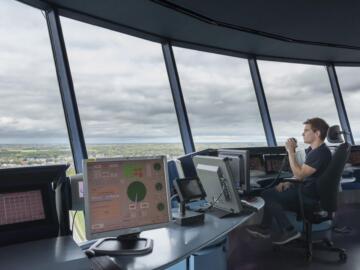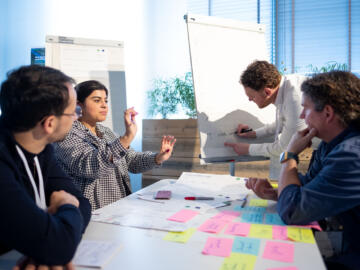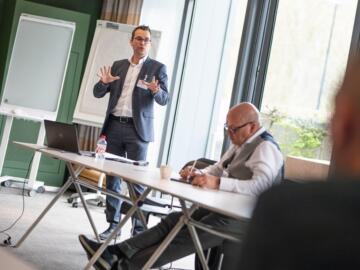Smart mobility requires – amongst many other factors – a dense network of ‘mobility hubs’, where people can easily switch between transportation modes. But to make these hubs attractive enough to generate a real impact on the current mobility, environmental and spatial challenges in Flanders, they will have to be much more than that. How do we design hubs in line with needs of both users and neighbours? And what opportunities do hubs bring for businesses? Fasten your seatbelts, as Tomorrowlab tackles the challenges and solutions.
Smart mobility requires – amongst many other factors – a dense network of ‘mobility hubs’, where people can easily switch between transportation modes. How do we design hubs in line with needs of both users and neighbours? What opportunities do hubs bring for businesses? Fasten your seatbelts, as Tomorrowlab tackles the challenges and solutions.
Smart Mobility starts from the idea that you can travel smoothly from your doorstep to your destination, by using just the right means tailored to your journey and your travel preferences. The backbone of such a system are mobility hubs or ‘nodes’, where you can switch from train to tram or bus, taxi, a shared car, bike, scooter or step. But they may also offer flexible workplaces, fitness and food amenities, e-commerce collections points... So what does this mean for hubs’ design, layout and roll-out?
Shared mobility: minds are maturing
Research shows that 50% of all cars travel less than 10.000 kms per year. Many don’t leave the garage for days in a row. Likewise, an interesting fact is that in the last decade, driving licenses issued in Belgium dropped by 30%. The younger generation clearly considers a privately owned car more a burden than a benefit, much less a status symbol. But they might use a shared car now and then for destinations hard to reach by public transport or bike. So why not turn parking spaces of businesses in or near residential areas - after office hours - into charging and parking spots for shared cars of the neighbourhood?
This is just one example of how EV sharing brings huge opportunities for businesses in multiple ways. It can generate visitor traffic to their site to showcase products and services. Rethinking business infrastructure in relation to the local population and surroundings opens the opportunity for offering a new service and generating additional revenue. Also, it is an asset for employees rethinking their mobility footprint. Last but not least, local authorities are crucial to act as the facilitator of EV mobility and will be happy when one creates extra room for redesigning public space for people to meet, park and share vehicles and experience the city.
Micro mobility: ‘bicycle first’ in the 15-minute city
If ‘short distance = bicycle’ becomes the lead principle, we must also rethink and redesign road infrastructure and public space, such as one-way streets with wide pavements. Access to micro mobility options - bicycles, e-scooters, and mopeds - will be vital to provide a convenient, affordable and safe transit-oriented urban hub system. Sharing systems are no doubt crucial, but need to be tailored to the urban or non-urban context. If you want people to live in the city, you have to get people easily from the centre to nature to relax and rewind.
Therefore mobility hubs will only be successful if they are close to the users’ home to start and end their journey. Hence the ‘15-minute city’ idea, which is based on research by Professor Carlos Moreno at the Sorbonne in Paris. The concept is one in which daily urban necessities are within a 15-minute reach on foot or by bike. Work, home, shops, entertainment, education and healthcare — in Moreno’s vision, these should all be available within the same time a commuter might once have waited on a railway platform.
The service station of the future: charge your car AND yourself
There’s no way back: our good old service stations will have to reinvent themselves too. Actually they are already doing that, joining forces with various suppliers of extra services. Fuel retailers need to move from a vehicle-centric to a customer-centric business model, and develop a corresponding response regarding products, services and the layout of stations and convenience stores, embracing new digital tools and acting as logistical service point for e-commerce.
Also, stations should reconsider their geographical coverage with regard to where the demand is and expand services with more than just electric charging. For example, TomorrowLab helped a major service station player to discover how future scenarios could result in a more robust strategy and roadmap. A new business mission was described as providing ‘sustainable mobility services for every customer journey.’ This resulted in a wide range of innovation projects, including support to a car sharing platform and a new on-demand roadside assistance service.
So, what will mobility hubs look like?
The conclusion of all these trends is that mobility hubs can take many shapes. They may vary in size, type of location, and service offering. They can be small and located in residential areas, with just one or two parking spots, or much bigger and positioned nearby major public transport interchanges. It can be gas station, or a car park on a business site. In the end, the key is that they should always be where supply and demand meet and help to dissuade citizens from owning private cars, resulting in cleaner, more liveable and pleasant cities.
Do you want to discover the business opportunities yourself?

The future looks bright
skeyes ensures the safety and efficiency of air traffic in Belgium. The air traffic controllers of skeyes supervise more than 3,000 aircraft every day, representing more than a million aircraft movements per year. The autonomous public company operates in the heart of Europe, in one of the continent's busiest and most complex airspaces.

Formats for reconnecting your teams
After months on our virtual island, we are stepping out of our cocoons again, still somewhat cautiously. Teams find each other again at the office, at the coffee machine (never underestimate the breeding ground power of the coffee machine!).

Mobility in Flanders: the future starts now
How do we connect Flanders’ people and businesses in a smooth, safe, healthy and futureproof way? This is our key challenge and the starting point of a daring glimpse into tomorrow’s mobility.

